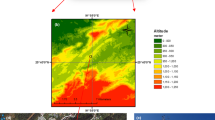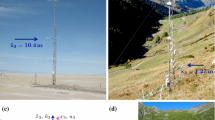Abstract
An expanded planar-fit (PF) method over complex terrain is presented and applied to coordinate rotation of the eddy-covariance (EC) flux and vertical velocity estimation. Theoretical analysis indicates that PF coefficients depend on wind direction, and an expression of vertical velocity is deduced. We applied the theory using 1 year of observations from the KoFlux site in the Gwangneung Forest in Korea and investigated the influence of wind direction on the PF method. Then, we performed an expansion of the PF method to consider dependence of PF coefficients on wind direction and applied the PF method to every sector. The results show that the PF coefficients and tilt angles over complex terrain vary with wind direction. Two hundred 30-min data sets are sufficient to derive stable PF coefficients over hilly terrain for each sector. The relative difference in eddy-covariance flux between the general planar fit (GPF) and sector planar fit (SPF) is less than 10% for the scalar flux and about 18% for friction velocity. Vertical velocity and vertical advection (VA) terms were also calculated and compared using SPF and GPF methods, and a normal distribution and diurnal trend of real vertical velocity on clear days are presented.










Similar content being viewed by others
References
Baldocchi D (1997) Flux footprints within and over forest canopies. Bound Layer Meteorol 85(2):273–292
Baldocchi DD (2003) Assessing the eddy covariance technique for evaluating carbon dioxide exchange rates of ecosystems: past, present and future. Glob Chang Biol 9(4):479–492
Baldocchi DD, Falge E, Gu L, Olson R, Hollinger D, Running S, Anthoni P, Bernhofer Ch, Davis K, Fuentes J, Goldstein A, Katul G, Law B, Lee X, Malhi Y, Meyers T, Munger W, Oechel W, Paw UKT, Pilegaard K, Schmid HP, Valentini R, Verma S, Vesala T, Wilson K, Wofsyn S (2001) FLUXNET: a new tool to study the temporal and spatial variability of ecosystem-scale carbon dioxide, water vapor, and energy flux densities. Bull Am Meteorol Soc 82:2415–2434
Campbell Scientific Ltd. (2007) CSAT3 Three Dimensional Sonic Anemometer User’s Guide, 70 pp
Feigenwinter C, Bernhofer C, Vogt R (2004) The influence of advection on the short term CO2 budget in and above a forest canopy. Bound Layer Meteor 113:201–224
Feigenwinter C, Bernhofer C et al (2008) Comparison of horizontal and vertical advective CO2 fluxes at three forest sites. Agric For Meteorol 148(1):12–24
Finnigan JJ (1999) A comment on the paper by Lee (1998): on micrometeorological observations of surface-air exchange over tall vegetation. Agric For Meteorol 97:55–64
Foken T, Gockede M, Mauder M, Mahrt L, Amiro BD, Munger JW (2004) Post-field data quality control. In: Lee X, Massman WJ, Law BE (eds) Handbook of micrometeorology. A guide for surface flux measurements. Kluwer, Dordrecht, pp 181–208
Heinesch B, Yernaux M et al (2007) Some methodological questions concerning advection measurements: a case study. Bound Layer Meteorol 122(2):457–478
Heinesch B, Yernaux Y et al (2008) Dependence of CO2 advection patterns on wind direction on a gentle forested slope. Biogeosciences 5(3):657–668
Hong J, Kim J, Lee D, Lim JH (2008) Estimation of the storage and advection effects on H2O and CO2 exchanges in a hilly KoFlux forest catchment. Water Resour Res 44: W01426. doi:10.1029/2007WR006408
LI-COR, Inc (1999) LI-7500 CO2/H2O Analyzer Instruction Manual, 133 pp
Kaimal JC, Finnigan JJ (1994) AtmosphericBoundary Layer Flows: Their Structure and Measurement. Oxford University Press, New York, p 289
Kim J, Guo Q et al (2006) Upscaling fluxes from tower to landscape: overlaying flux footprints on high-resolution (IKONOS) images of vegetation cover. Agric For Meteorol 136(3–4):132–146
Kwon H, Park SB, Kang M, Yoo J, Yuan RM, Kim J (2007) Quality control and assurance of Eddy covariance data at the two KoFlux sites. Korean J Agric For Meteorol 9:260–267
Lee X (1998) On micrometeorological observations of surface-air exchange over tall vegetation. Agric For Meteorol 91:39–49
Lee X, Hu X (2002) Forest-air fluxes of carbon, water and energy over non-flat terrain. Bound Layer Meteorol 103:277–301
Lee X, Massman W, Law B (2004) Handbook of micro-meteorology: a guide for surface flux measurement and analysis. Kluwer Academic Publishers, Dordrecht, p 250
Leuning R, Zegelin SJ et al (2008) Measurement of horizontal and vertical advectlion of CO2 within a forest canopy. Agric For Meteorol 148:1777–1797
Mammarella I, Kolari P et al (2007) Determining the contribution of vertical advection to the net ecosystem exchange at Hyytiala forest, Finland. Tellus B Chem Phys Meteorol 59(5):900–909
Mauder M, Oncley SP et al (2007) The energy balance experiment EBEX-2000. Part II: Intercomparison of eddy-covariance sensors and post-field data processing methods. Bound Layer Meteorol 123(1):29–54
Oncley SP, Foken T et al (2007) The energy balance experiment EBEX-2000. Part I: Overview and energy balance. Bound Layer Meteorol 123(1):1–28
Ono K, Mano M, Miyata A, Inoue Y (2008) Applicability of the planar fit technique in estimating surface fluxes over flat terrain using eddy covariance. J Agric Meteorol 64:121–130
Paw UKT, Baldocchi DD, Meyers TP, Wilson KB (2000) Correction of eddy-covariance measurements incorporating both advective effects and density fluxes. Bound Layer Meteorol 97:487–511
Sun JL (2007) Tilt corrections over complex terrain and their implication for CO2 transport. Bound Layer Meteorol 124(2):143–159
Tanner CB, Thurtell GW (1969) Anemoclinometer measurements of Reynolds stress and heat transport in the atmospheric surface layer, Research and Development Tech. Report ECOM 66–G22-F to the US Army Electronics Command, Dept. Soil Science. University of Wisconsin, Madison
Vickers D, Mahrt L (2006) Contrasting mean vertical motion from tilt correction methods and mass continuity. Agric For Meteorol 138(1–4):93–103
Webb EK, Pearman GI, Leuning R (1980) Correction of the flux measurements for density effects due to heat and water vapour transfer. Quart J Roy Meteorol Soc 106:85–100
Wilczak JM, Oncley SP, Stage S (2001) Sonic anemometer tilt correction algorithms. Bound Layer Meteorol 99:127–150
Yu GR, Wen XF, Tanner BD, Sun XM, Lee X, Chen JY (2006) Overview of ChinaFLUX and evaluation of its eddy covariance measurement. Agric For Meteorol 137:125–137
Acknowledgments
This research was supported in part by the Knowledge Innovation Project of the Chinese Academy of Sciences (No. KZCX2-YW-QN502), and a grant (Code: 1-8-2) from Sustainable Water Resources Research Center of 21st Century Frontier Research Program, the Eco-Technopia 21 Project from the Ministry of Environment, and the BK21 program from the Ministry of Education and Human Resource Management of Korea. Ministry. Thanks will be given to Dr. Yonghua Wu, Optical Remote Sensing Lab, The City College of New York, for his revision and comments on the manuscript. We also thank an anonymous reviewer for his constructive and helpful comments.
Author information
Authors and Affiliations
Corresponding author
Rights and permissions
About this article
Cite this article
Yuan, R., Kang, M., Park, SB. et al. Expansion of the planar-fit method to estimate flux over complex terrain. Meteorol Atmos Phys 110, 123–133 (2011). https://doi.org/10.1007/s00703-010-0113-9
Received:
Accepted:
Published:
Issue Date:
DOI: https://doi.org/10.1007/s00703-010-0113-9




